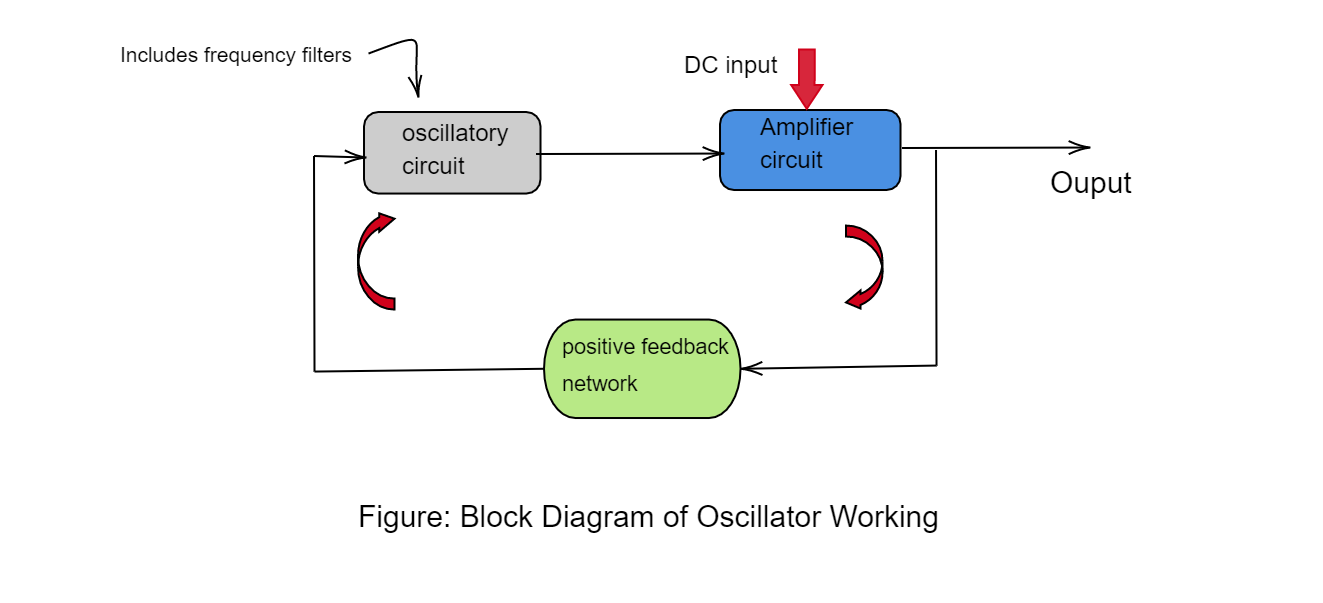
An oscillator is nothing but an amplifier with
(a) positive feedback
(b) large gain
(c) no feedback
(d) negative feedback
Answer
567.3k+ views
Hint:Oscillator circuits are just amplifier circuits where the output voltage is fed to the input again and frequency filter is used to give periodicity to the produced signal.. Hence, producing continuity and oscillation to the output voltage. (just like any other periodic signal like a sine wave)
Explanation:
Diagram: it shows schematic units for working of oscillator:

An electronic oscillator is used to produce an alternating signal (for an example sine wave, square wave). They convert DC (direct current) input to AC (alternating current) output. The most common type of oscillator is an amplifier (for example an operational amplifier, transistor) in a feedback loop. In this type of oscillator, the output is fed back to the input after passing through a frequency filter.
When the DC supply is switched on, there are electronic noises in the circuit which are fed back to the input through a filter. This amplified reduced noise follows the same process until we get a sine wave in the end as the output of the oscillator.
The RC oscillator circuit is an example of a positive feedback oscillator. Here, some part of the output signal is fed back to the input to ensure that the feedback signal is generated again and amplified. This is to make sure that the output signal is constant.
Final Answer
An oscillator is nothing but an amplifier with (a) positive feedback.
Note:
1. Positive feedback is when the output signal obtained is fed to the input again but it should be in phase and negative feedback when out of phase is fed.
2. Frequency filters enable the separation and selection of only positive phase feedback signals from the output.
Explanation:
Diagram: it shows schematic units for working of oscillator:

An electronic oscillator is used to produce an alternating signal (for an example sine wave, square wave). They convert DC (direct current) input to AC (alternating current) output. The most common type of oscillator is an amplifier (for example an operational amplifier, transistor) in a feedback loop. In this type of oscillator, the output is fed back to the input after passing through a frequency filter.
When the DC supply is switched on, there are electronic noises in the circuit which are fed back to the input through a filter. This amplified reduced noise follows the same process until we get a sine wave in the end as the output of the oscillator.
The RC oscillator circuit is an example of a positive feedback oscillator. Here, some part of the output signal is fed back to the input to ensure that the feedback signal is generated again and amplified. This is to make sure that the output signal is constant.
Final Answer
An oscillator is nothing but an amplifier with (a) positive feedback.
Note:
1. Positive feedback is when the output signal obtained is fed to the input again but it should be in phase and negative feedback when out of phase is fed.
2. Frequency filters enable the separation and selection of only positive phase feedback signals from the output.
Recently Updated Pages
A man running at a speed 5 ms is viewed in the side class 12 physics CBSE

The number of solutions in x in 02pi for which sqrt class 12 maths CBSE

State and explain Hardy Weinbergs Principle class 12 biology CBSE

Write any two methods of preparation of phenol Give class 12 chemistry CBSE

Which of the following statements is wrong a Amnion class 12 biology CBSE

Differentiate between action potential and resting class 12 biology CBSE

Trending doubts
What are the major means of transport Explain each class 12 social science CBSE

Which are the Top 10 Largest Countries of the World?

Draw a labelled sketch of the human eye class 12 physics CBSE

Explain sex determination in humans with line diag class 12 biology CBSE

Explain sex determination in humans with the help of class 12 biology CBSE

Differentiate between homogeneous and heterogeneous class 12 chemistry CBSE




